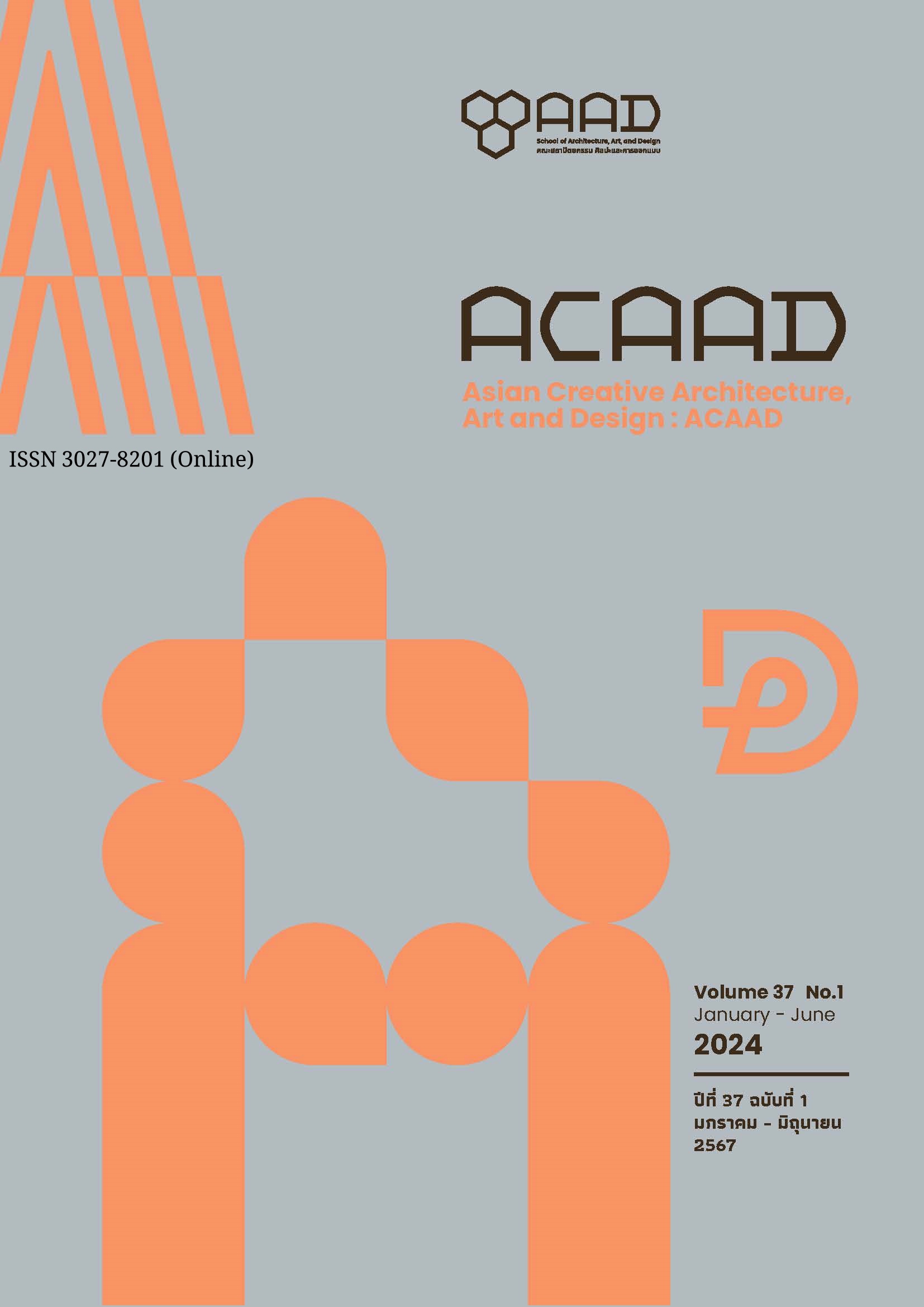Spatial design guidelines for waterfall tourist attraction: A case study in Wang Hin Lat Waterfall, Trang province
Main Article Content
Abstract
This article investigates the sustainable development of the Wang Hin Lat waterfall tourist attraction, focusing on spatial design and land use. A field survey collected physical data, including topography, tourist attraction resources, facilities, land use, and access while community needs were gathered through focus group meetings, and tourist behavior was observed. The analyzed data led to proposed guidelines for tourist attraction development, emphasizing area utilization, carrying capacity, layout plan, and management. Despite the waterfall's natural beauty and provincial popularity, deficiencies in infrastructure, utilities, facilities, and land use planning contribute to congestion issues. It is a small waterfall capable of accommodating a limited number of tourists. Recommendations for Wang Hin Lat waterfall development include clearly defining and prioritizing zoning for natural areas, recreation zones, service and office areas, shops, parking, and entrances. A suggested tourist limit of 300, with access control points, aims to manage congestion. Diversifying activities, such as promoting nature, culture, and lifestyle learning, developing nature trails, and establishing clear regulations, is essential for the sustainable coexistence of tourist attraction development and nature conservation.
Article Details

This work is licensed under a Creative Commons Attribution-NonCommercial-NoDerivatives 4.0 International License.
This work is licensed under a Creative Commons Attribution-NonCommercial-ShareAlike 4.0 International License.
Copyright Transfer Statement
The copyright of this article is transferred to Journal of The Faculty of Architecture King Mongkut's Institute of Technology Ladkrabang with effect if and when the article is accepted for publication. The copyright transfer covers the exclusive right to reproduce and distribute the article, including reprints, translations, photographic reproductions, electronic form (offline, online) or any other reproductions of similar nature.
The author warrants that this contribution is original and that he/she has full power to make this grant. The author signs for and accepts responsibility for releasing this material on behalf of any and all co-authors.
References
Arayanimitskul, C. (2015). Plants in landscape architecture. Chulalongkorn University Press. (in Thai)
Bahee, B., Jehno, N., Samahae, A., Samoh, N., Kenanga, A., Waranantakul, W., Kaewfai, J., & Waranantakul, O. (2021). The study of potential of eco-tourist attraction: A case study of Than To waterfall, Than To district, Yala province. Journal of Liberal Arts, RMUTT. 3(1), 1-13. (in Thai)
Breiby, M. A. (2014). Exploring aesthetic dimensions in a nature-based tourism context. Journal of vacation marketing, 20(2), 163-173. https://doi.org/10.1177/1356766713514243
Chougule, B. (2011). Environmental carrying capacity and ecotourism development. International Journal of Economic Issues, 4(1), 45-54.
Department of the Interior, Bureau of Outdoor Recreation. (1967). Outdoor recreation space standards. n.p.
Department of Tourism. (2014a). Ecotourism quality standards assessment guide (2nd ed.). The War Veterans Organization of Thailand. (in Thai)
Department of Tourism. (2014b). Guide to assessment of tourist attraction quality standards waterfall type (2nd ed.). The War Veterans Organization of Thailand. (in Thai)
European Union European Regional Development Fund. (2020). Guidelines for developing a sustainable tourism in protected areas. n.p.
Irina-Ramona, P. (2016). Ecotourism and sustainable development. Annals of the ‘Constantin Brancusi’University of Targu Jiu’, Enginnering Series, 3, 189-192.
Kosol, O., & Suttawet, C. (2014). Sustainable tourism management for supporting ASEAN economics community. Journal of Politics and Governance, 4(1), 220-232. (in Thai)
Kueseng, T., Rukwong, M., Sawaain, R., Wilairat W., & Phuaamnat, L. (2016). Tourists, expectation and satisfaction regarding on-site environment management in Sai Khao waterfall. The 5th National and International Academic Conference 2016. Think globally, act locally: paradigms in research creativity. (pp. 296-306). Yala Rajabhat University. (in Thai)
Lertpongmanee, K. (2022). Community-based tourism management for sustainable tourism development. The Journal of Pacific Institute of Management Science (Humanities and Social Science), 8(1), 19-33. (in Thai)
Ministry of Tourism & Sports. (2017). National tourism development plan no. 2 (2017–2021). The War Veterans Organization of Thailand. (in Thai)
Ministry of Tourism and Sports. (2019). A complete report on the project to promote sustainable tourism. n.p. (in Thai)
Mree, C. L., Das, S., Ray, T. K., Chowdhury, P., & Saha, N. (2020). Residents’ perception of ecotourism in Ratargul freshwater swamp forest of Bangladesh. Asian Journal of Research in Agriculture and Forestry, 5(3), 1-11. https://doi.org/10.9734/ajraf/2020/v5i330083
Mueangkaeo, M. (2019, February 20). Chi Chut Laeng Thiao Mai: Wang Hin Lat Pai Thiao Phakphon Samphat Akat Borisut. MGR Online. https://mgronline.com/south/detail/9620000017781 (in Thai)
Naktae, W., Kutintara, U., & Emphandhu, D. (2014). Participatory assessment of natural tourism resources potential at reservoir area of Rajjaprapha dam in Khaosok national park, Suratthani province. Journal of Social Research. 37(1), 125-150. (in Thai)
Nguanson, C. (2017). Development and guidelines for sustainable development of Yan Ta Khao, Trang province. Journal of Environmental Design, 4(2), 51-66. (in Thai)
Office of Natural Resources and Environmental Policy and Planning. (2015). Natural Environment Quality Standard Manual Waterfall type. n.p. (in Thai)
Swangkong, K. (2015). The potential assessment of waterfall attractions in Saraburi province. Suthiparithat (Journal of Business and Innovation: SJBI), 29(89), 179-194. (in Thai)
Thittiyanin, N. (2022). Guidelines for bicycle route-based ecotourism: The case study of Yan Ta Khao district, Trang province. Journal of Environmental Design, 9(2), 114-137. (in Thai)
Thumsai, N., & Pookongchai, K. (2020). Civil partnership model in tourist attraction management: A case study of Tham Phra waterfall Seka subdistrict Bueng Kan province. Pa~n~na Panithan Journal, 5(1), 203-217. (in Thai)
Tourism Authority of Thailand. (1984). Guide to the development of tourist attractions in the waterfall type. n.p. (in Thai)
Wechtunyagul, P. (2020). Ecotourism to sustainable tourism. Journal of Sustainable Tourism Development, 2(1), 50-63. (in Thai)
Yimsrual, S., & Theppituck, T. (2017). The use of local identity to design facilities for developing Lanna hot spring tourism cluster. n.p. (in Thai)
Yimsrual, S. (2018). Tourism facilities and landscape design guideline for natural hot spring tourist attraction. Journal of Environmental Design, 5(2), 100-129. (in Thai)


